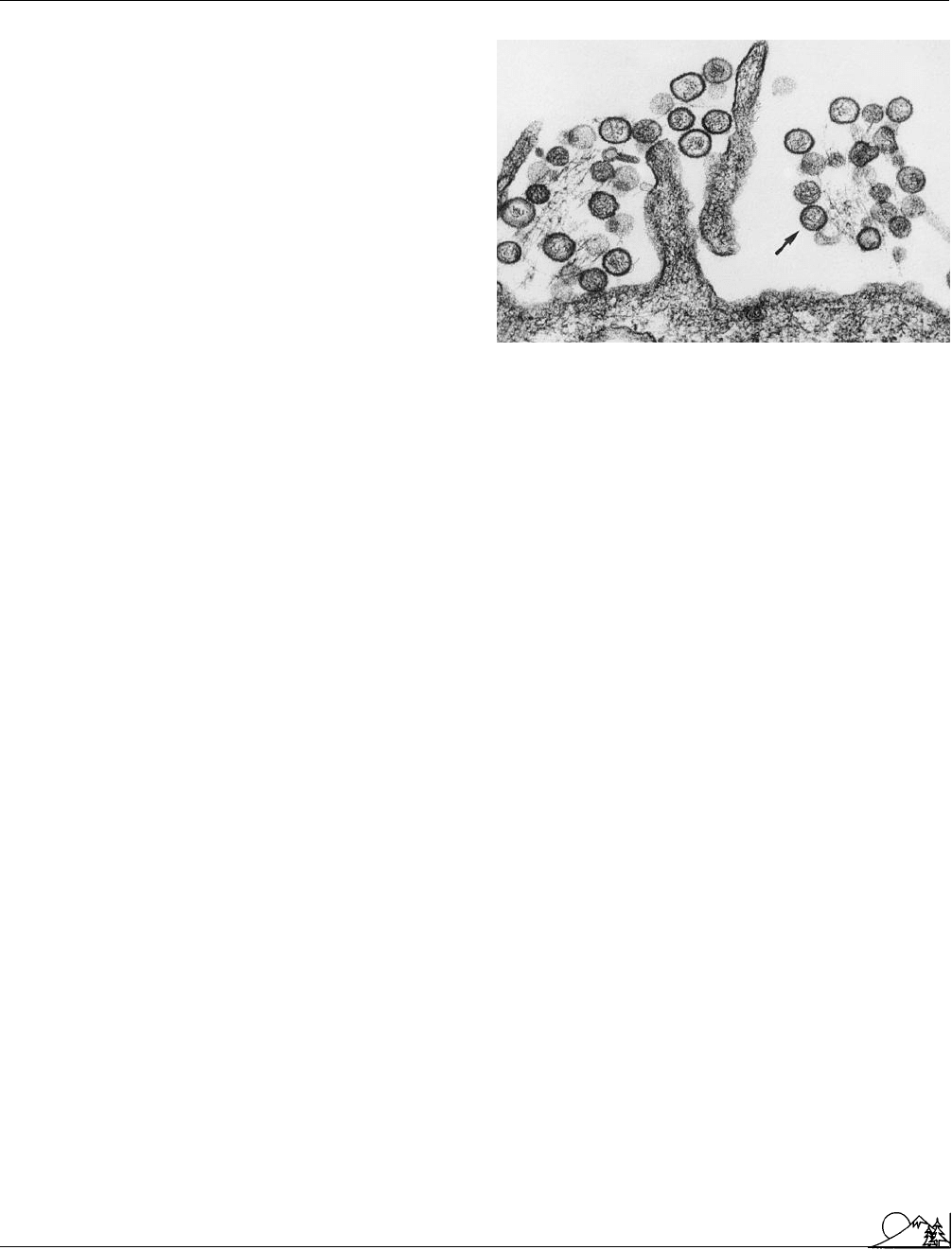Environmental Encyclopedia
Подождите немного. Документ загружается.


Environmental Encyclopedia 3
Eastern European pollution
The group carries out its work by recruiting volunteers
to serve in an environmental EarthCorps and to work with
research scientists on important environmental issues. The
volunteers, who pay from $800 to over $2,500 to join two-
or three-week expeditions to the far corners of the globe,
gain valuable experience and knowledge on situations that
affect the earth and human welfare.
By 2002, Earthwatch has sponsored over 1,180 proj-
ects in 50 countries around the world. By the end of the
year it expects to have mobilized 4,300 volunteers, ranging
in ages from 16 to 85, on 780 research teams. They will
address such topics as
tropical rain forest ecology
and
conservation
; marine studies (ocean ecology); geosciences
(climatology, geology, oceanography, glaciology, volca-
nology, paleontology); life sciences (
wildlife management
,
biology, botany, ichthyology, herpetology, mammalogy, or-
nithology, primatology, zoology); social sciences (agriculture,
economic anthropology, development studies, nutrition,
public health); and art and archaeology (architecture, archae-
oastronomy, ethnomusicology, folklore).
Since it was founded in 1971, Earthwatch has orga-
nized over 60,000 EarthCorps volunteers, who have contrib-
uted over $22 million and more than four million hours on
some 1,500 projects in 150 countries and 36 states. No
special skills are needed to be part of an expedition, and
anyone 16 years or older can apply. Scholarships for students
and teachers are also available. Earthwatch’s affiliate, The
Center for Field Research, receives several hundred grant
applications and proposals every year from scientists and
scholars who need volunteers to assist them on study expedi-
tions.
Earthwatch publishes Earthwatch magazine six times
a year, describing its research work in progress and the
findings of previous expeditions. The group has offices in
Los Angeles, Oxford, Melbourne, Moscow, and Tokyo and
is represented in all 50 American states as well as in Ger-
many, Holland, Italy, Spain, and Switzerland by volunteer
field representatives.
[Lewis G. Regenstein]
R
ESOURCES
O
RGANIZATIONS
Earthwatch, 3 Clock Tower Place, Suite 100 Box 75, Maynard, MA USA
01754 (978) 461-0081, Fax: (978) 461-2332, Toll Free: (800) 776-0188,
Email: info@earthwatch.org, <http://www.earthwatch.org>
Eastern European pollution
Between 1987 and 1992 the disintegration of Communist
governments of Eastern Europe allowed the people and press
of countries from the Baltic to the Black Sea to begin re-
407
counting tales of life-threatening
pollution
and disastrous
environmental conditions in which they lived. Villages in
Czechoslovakia were black and barren because of
acid rain
,
smoke
, and
coal
dust from nearby factories. Drinking water
from Estonia to Bulgaria was tainted with toxic
chemicals
and untreated sewage. Polish garden vegetables were inedible
because of high
lead
and
cadmium
levels in the soil.
Chronic health problems were endemic to much of the re-
gion, and none of the region’s new governments had the
spare cash necessary to alleviate their environmental liabil-
ities.
The air,
soil
, and
water pollution
exposed by new
environmental organizations and by a newly vocal press had
its roots in Soviet-led efforts to modernize and industrialize
Eastern Europe after 1945. (Often the term “Central Eu-
rope” is used to refer to Poland, Czech Republic, Slovakia,
Hungary, Yugoslavia, and Bulgaria, and “Eastern Europe”
to refer to the Baltic states, Belarus, and Ukraine. For the
sake of simplicity, this essay uses the latter term for all these
states.) Following Stalinist theory that modernization meant
industry, especially heavy industries such as coal mining, steel
production, and chemical manufacturing, Eastern European
leaders invested heavily in industrial buildup. Factories were
often built in resource-poor areas, as in traditionally agricul-
tural Hungary and Romania, and they rarely had efficient
or clean technology. Production quotas generally took prece-
dence over health and environmental considerations, and
billowing smokestacks were considered symbols of national
progress. Emission controls on smokestacks and waste
efflu-
ent
pipes were, and are, rare. Soft, brown lignite coal, cheap
and locally available, was the main fuel source. Lignite con-
tains up to 5% sulfur and produces high levels of
sulfur
dioxide
,
nitrogen oxides
, particulates, and other pollutants
that contaminate air and soil in population centers, where
many factories and
power plants
were built. The region’s
water quality
also suffers, with careless disposal of toxic
industrial wastes, untreated urban waste, and
runoff
from
chemical-intensive agriculture.
By the 1980s the effects of heavy industrialization
began to show. Dependence on lignite coal led to sulfur
dioxide levels in Czechoslovakia and Poland eight times
greater than those of Western Europe. The industrial trian-
gle of Bohemia and Silesia had Europe’s highest concentra-
tions of ground-level
ozone
, which harms human health
and crops. Acid rain, a result of industrial
air pollution
,
had destroyed or damaged half of the forests in the former
East Germany and the Czech Republic. Cities were threat-
ened by outdated factory equipment and aging chemical
storage containers and pipelines, which leaked
chlorine
,
aldehydes, and other noxious gases. People in cities and
villages experienced alarming numbers of
birth defects
and
short life expectancies. Economic losses, from health care

Environmental Encyclopedia 3
Eastern European pollution
expenses, lost labor, and production inefficiency further
handicapped hard-pressed Eastern European governments.
Popular protests against environmental conditions
crystallized many of the movements that overturned Eastern
and Central European governments. In Latvia, expose
´
son
petrochemical poisoning
and on environmental conse-
quences of a hydroelectric project on Daugava River sparked
the Latvian Popular Front’s successful fight for indepen-
dence. Massive campaigns against a proposed dam on the
Danube River helped ignite Hungary’s political opposition
in 1989. In the same year, Bulgaria’s Ecoglasnost group held
Sofia’s first non-government rally since 1945. The Polish
Ecological Club, the first independent environmental orga-
nization in Eastern Europe, assisted the Solidarity move-
ment in overturning the Polish government in the mid-
1980s.
Citizens of these countries rallied around environmen-
tal issues because they had first-hand experience with the
consequences of pollution. In Espenhain, of former East
Germany, 80% of children developed chronic
bronchitis
or
heart ailments before they were eight years old. Studies
showed that up to 30% of Latvian children born in 1988
may have suffered from birth defects, and both children and
adults showed unusually high rates of
cancer
,
leukemia
,
skin diseases, bronchitis, and asthma. Czech children in
industrial regions had acute
respiratory diseases
, weak-
ened immune systems, and retarded bone development, and
concentrations of lead and cadmium were found in children’s
hair. In the industrial regions of Bulgaria skin diseases were
seven times more common than in cleaner areas, and cases
of rickets and liver diseases were four times as common.
Much of the air and soil contamination that produced these
symptoms remains today and continues to generate health
problems.
Water pollution is at least as threatening as air and
soil pollution. Many cities and factories in the region have
no facilities for treating
wastewater
and sewage. Existing
treatment facilities are usually inadequate or ineffective.
Toxic waste dumps containing old and rusting barrels of
hazardous materials are often unmonitored or unidentified.
Chemical
leaching
from poorly monitored waste sites
threatens both surface water and
groundwater
, and water
clean enough to drink has become a rare commodity. In
Poland untreated sewage, mine
drainage
, and factory efflu-
ents make 95% of water unsafe for drinking. At least half
of Polish rivers are too polluted, by government assessment,
even for industrial use. According to government officials,
70% of all rivers in the industrial Czech region of Bohemia
are heavily polluted, 40% of wastewater goes untreated, and
nearly a third of the rivers have no fish. In Latvia’s port
town of Ventspils, heavy oil lies up to 3 ft (1 m) thick on
408
the river bottom. Phenol levels in the nearby Venta River
exceed official limits by 800%.
Few pollution problems are geographically restricted
to the country in which they were generated. Shared rivers
and aquifers and regional weather patterns carry both air-
borne and water-borne pollutants from one country to an-
other. The Chernobyl nuclear reactor disaster, which spread
radioactive gases and particulates from Belarus across north-
ern Europe and the Baltic Sea to northern Norway and
Sweden is one infamous example of trans-border pollution,
but other examples are common. The town of Ruse, Bulgaria
has long been contaminated by chlorine gas emissions from
a Romanian plant just across the Danube. Protests against
this poisoning have unsettled Bulgarian and Romanian rela-
tions since 1987. Toxic wastes flowing into the Baltic Sea
from Poland’s Vistula River continue to endanger fisheries
and shoreline habitats in Sweden, Germany, and Finland.
The Danube River is a particularly critical case. Accu-
mulating and concentrating urban and industrial waste from
Vienna to the Black Sea, this river supports industrial com-
plexes of Austria, Czechia, Hungary, Croatia, Serbia, Bul-
garia, and Romania. Before the Danube leaves Budapest, it
is considered unsafe for swimming. Like other rivers, the
Danube flows through a series of industrial cities and mining
regions, each river uniting the pollution problems of several
countries. Each city and farm along the way uses the contam-
inated water and contributes some pollutants of its own.
Also like other rivers, the Danube carries its toxic load into
the sea, endangering the marine environment.
Western countries from Sweden to the United States
have their share of pollution and environmental disasters.
The Rhine and the Elbe have disastrous
chemical spills
like
those on the Danube and the Vistula. Like recent communist
regimes, most western business leaders would prefer to disre-
gard environmental and human health considerations in their
pursuit of production quotas. Yet several factors set apart
environmental conditions in Eastern Europe. Aside from its
aged and outdated equipment and infrastructure, Eastern
Europe is handicapped by its compressed geography, intense
urbanization near factories, a long-standing lack of informa-
tion and accurate records on environmental and health con-
ditions, and severe shortages of clean-up funds, especially
hard currency.
Eastern Europe’s dense settlement crowds all the in-
dustrial regions of the Baltic states, Poland, the Czech and
Slovak republics, and Hungary into an area considerably
smaller than Texas but with a much higher population.
This industrial zone lies adjacent to crowded manufacturing
regions of Western Europe. In this compact region, people
farm the same fields and live on the same mountains that
are stripped for mineral extraction. Cities and farms rely on
aquifers and rivers that receive factory effluent and
pesticide

Environmental Encyclopedia 3
Ebola
runoff immediately upstream. Furthermore, post-1945 in-
dustrialization gathered large labor forces into factory towns
more quickly than adequate infrastructure could be built.
Expanding urban populations had little protection from the
unfiltered pollutants of nearby furnaces. At the same time
that many Eastern Europeans were eye witnesses to environ-
mental transgressions, little public discussion about the prob-
lem was possible. Official media disliked publicizing health
risks or the destruction of forests, rivers, and lakes. Those
statistics
that existed were often unreliable. Air and water
quality data were collected and reported by industrial and
government officials, who could not afford bad test results.
Now that environmental conditions are being exposed,
cleanup efforts remain hampered by a shortage of funding.
Poland’s long-term environmental restoration may cost $260
billion, or nearly eight times the country’s annual GNP in
the mid-1980s. Efforts to cut just sulfur dioxide emissions
to Western standards would cost Poland about $2.4 billion
a year. Hungary, with a mid-1980s GNP of $25 billion,
could begin collecting and treating its sewage for about $5
billion. Cleanup in the port of Ventspils, Latvia, is expected
to cost 3.6 billion rubles and $1.5 billion in hard currency.
East German air, soil, and water
remediation
get a boost
from their western neighbors, but the bill is expected to run
between $40 and $150 billion.
Ironically, East European leaders see little choice for
raising this money aside from expanded industrial produc-
tion.Meanwhile, business leaders urge production expansion
for other capital needs. Some Western investment in cleanup
work has begun, especially on the part of such countries as
Sweden and Germany, which share rivers and seas with
polluting neighbors. Already in 1989 Sweden had begun
work on water quality monitoring stations along Poland’s
Vistula River, which carries pollutants into the Baltic Sea.
Capital necessary to purchase mitigation equipment, im-
prove factory conditions, rebuild rusty infrastructure, and
train environmental experts will probably be severely limited
for decades to come, however.
Meanwhile, western investors are flocking to Eastern
and Central Europe in hopes to build or rebuild business
ventures for their own gain. The region is seen as one of
quick growth and great potential. Manufacturers in heavy
and light industries, automobiles, power plants, and home
appliances are coming from Western Europe, North
America, and Asia. From textile manufacturing to agribusi-
ness, outside investors hope to reshape Eastern economies.
Many Western companies are improving and updating
equipment and adding
pollution control
devices. In a
cli-
mate
of uncertain regulation and rushed economic growth,
however, no one knows if the region’s new governments will
be able or willing to enforce environmental safeguards or if
409
the new investors will take advantage of weak regulations
and poor enforcement as did their predecessors.
[Mary Ann Cunningham Ph.D.]
R
ESOURCES
B
OOKS
French, H. F. “Restoring the Eastern European and Soviet Environments.”
In State of the World 1991. New York: Norton, 1991.
Feshbach, M., and A. Friendly, Jr. Ecocide in the USSR. New York: Basic
Books, 1992.
P
ERIODICALS
Hartsock, J. “Latvia’s Toxic Legacy.” Audubon 94 (1992): 27-8.
Wallich, P. “Dark Days: Eastern Europe Brings to Mind the West’s Pol-
luted History.” Scientific American 263 (1990): 16, 20.
Ebola
Ebola is a highly deadly viral hemorrhagic disease. As the
disease progresses, the walls of blood vessels break down
and blood gushes from every tissue and organ. The disease
is caused by the Ebola
virus
, named after the river in Zaire
(now the Democratic Republic of Congo) where the first
known outbreak occurred. The disease is extremely conta-
gious and exceptionally lethal. Where a 10%
mortality
rate
is considered high for most infectious diseases, Ebola can
kill up to 90% of its victims, usually within only a few
days after exposure. It seems to take direct contact with
contaminated blood or bodily fluids to catch the disease.
Health personnel and caregivers are often the most likely to
be infected. Even after a patient has died, preparing the
body for a funeral can be deadly for families members.
The Ebola virus is one of two members of a family of
RNA viruses called the Filoviridae. The other filovirus causes
Marburg fever, an equally contagious and lethal hemorrhagic
disease, named after a German town where it was first con-
tracted by laboratory workers who handled imported mon-
keys infected with the virus. Together with members of three
other families (arenaviruses, bunyanviruses, and flaviviruses),
these viruses cause a group of deadly, episodic diseases in-
cluding Lassa fever, Rift Valley fever, Bolivian fever, and
Hanta or Four-Corners fever (named after the region of the
southwestern United States where it was first reported).
The viruses associated with most of these emergent,
hemorrhagic fevers are zoonotic. That means a
reservoir
of pathogens naturally resides in an animal host or arthropod
vector. We don’t know the specific host or vector for Ebola,
but monkeys and other primates can contract related dis-
eases. People who initially become infected with Ebola often

Environmental Encyclopedia 3
Ebola
have been involved in killing, butchering, and eating gorillas,
chimps, or other primates. Why the viruses remain peacefully
in their hosts for many years without causing much more
trouble than a common cold, but then erupt sporadically
and unpredictably into terrible human epidemics, is a new
and growing question in
environmental health
.
The geographical origin for Ebola is unknown, but all
recorded outbreaks have occurred in or around Central Af-
rica, or in animals or people from this area. Ebola appears
every few years in Africa. Confirmed cases have occurred in
the Democratic Republic of the Congo, Gabon, Sudan,
Uganda, and the Ivory Coast. No case of the disease in
humans has ever been reported in the United States, but a
variant called Ebola-Reston virus killed a number of mon-
keys in a research facility in Reston, Virginia. A fictionalized
account of this outbreak was made into a movie called “Hot
Zone.” There probably are isolated cases in remote areas that
go unnoticed. In fact, the disease may have been occurring in
secluded villages deep in the jungle for a long time without
outside attention. The most recent Ebola outbreak was in
2002 when about 100 people died in a remote part of Gabon
and an adjacent area in Congo.
The worst epidemic of Ebola in humans occurred in
1995, in Kikwit, Zaire (now the Democratic Republic of
Congo). Although many more people died in Kikwit that
in any other outbreak, in many ways, the medical and social
effects of the epidemic there was typical of what happens
elsewhere. The first Kikwit victim was a 36-year-old labora-
tory technician named Kimfumu, who checked into a medi-
cal clinic complaining of a severe headache, stomach pains,
fever, dizziness, weakness, and exhaustion. Surgeons did an
exploratory operation to try to find the cause of his illness.
To their horror, they found his entire gastrointestinal tract
was necrotic and putrefying. He bled uncontrollably, and
within hours was dead. By the next day, the five medical
workers who had cared for Kimfumu, including an Italian
nun who assisted in the operation, began to show similar
symptoms, including high fevers, fatigue, bloody diarrhea,
rashes, red and itchy eyes, vomiting, and bleeding from every
body orifice. Less than 48 hours later, they, too, were dead,
and the disease was spread throughout the city of 600,000.
As panicked residents fled into the bush, government
officials responded to calls for help by closing off all travel—
including humanitarian aid—into or out of Kikwit, about
250 mi (400 km) from Kinshasa, the national capitol. Fearful
neighboring villages felled trees across the roads to seal off
the pestilent city. No one dared enter houses where dead
corpses rotted in the intense tropical heat. Boats plying the
adjacent Kwilu River refused to stop to take on or
discharge
passengers or cargo. Food and clean water became scarce.
Hospitals could hardly function as medicines and medical
personal became scarce. Within a few weeks, about 400
410
An electron micrograph of the ebola virus and
the hanta virus. (Delmar Publishers Inc. Reproduced
by permission.)
people in Kikwit had contracted the disease and at least 350
were dead. Eventually, the epidemic dissipated and disap-
peared. It isn’t known why the infection rate dropped or
what residents might do to prevent a further reappearance
of the terrible disease.
Because health professionals are among the most likely
to be exposed to Ebola when an outbreak occurs, it is impor-
tant for them to have access to rapid antigen or antibody
assays and isolation facilities to prevent further spread of
the virus. Unfortunately, these advanced medical procedures
generally are lacking in the African hospitals where the
disease is most likely to occur. There is no standard treatment
for Ebola other than supportive therapy. Patients are given
replacement fluids and electrolytes, and oxygen levels and
blood pressure are stabilized as much as possible. During
the Kikwit outbreak, eight patients were given blood of
individuals who had been infected with the virus but who
had recovered. It was hoped that their blood might have
antibodies to fight the infection. Seven of the eight transfu-
sion patients survived, but the number tested is too small
to be sure this was statistically significant. There is no vaccine
or other antiviral drug available to prevent or halt an in-
fection.
Several factors seem to be contributing to the appear-
ance and spread of highly contagious diseases such as Ebola
and Marburg fevers. With 6 billion people now inhabiting
the planet, human densities are much higher enabling germs
to spread further and faster than ever before. Expanding
populations push people into remote areas where they en-
counter new pathogens and
parasites
. Environmental
change is occurring on a larger scale: cutting forests, creating
unhealthy urban surroundings, and causing global-climate
change, among other things. Elimination of predators and

Environmental Encyclopedia 3
Eco Mark
habitat
changes favor disease-carrying organisms such as
mice, rats, cockroaches, and mosquitoes.
Another important factor in the spread of many dis-
eases is the speed and frequency of modern travel. Millions
of people go every day from one place to another by airplane,
boat, train, or
automobile
. Very few places on earth are
more than 24 hours by jet plane from any other place. In
2001, a woman flying from the Congo arrived in Canada
delirious with a high fever. She didn’t, in fact, have Ebola,
but Canadian officials were concerned about the potential
spread of the disease. Finding ways to cure Ebola and prevent
its spread may be more than simply a humanitarian concern
for its victims in Central Africa. It might be very much in
our own self-interest to make sure that this terrible disease
doesn’t cross our borders either accidentally or intentionally
through actions of a terrorist organization.
[William P. Cunningham Ph.D.]
R
ESOURCES
B
OOKS
Close, William T. Ebola: Through the Eyes of the People. London: Meadow-
lark Springs Productions, 2001.
Drexler, Madeline. Secret Agents: the Menace of Emerging Infections. Joseph
Henry Press, 2002.
Preston, Richard. The Hot Zone. Anchor Books, 1995.
O
THER
Disease Information Fact Sheets: Ebola hemorrhagic fever. 2002. Center for
Disease Control and Prevention. [cited July 9, 2002]. <http://www.cdc.gov/
ncidod/dvrd/spb/mnpages/dispages/ebola.html>.
P
ERIODICALS
Daszak, P. et al. 2000."Emerging Infectious Diseases of Wildlife-Threats
to Biodiversity and Human Health.” Science(US) 287: 443-449.
Hughes, J.M. “Emerging infectious diseases: a CDC perspective.” Emerging
Infectious Diseases. 7(2001):494-6.
Osterholm, M. T. “Emerging Infections—Another Warning.” The New
England Journal of Medicine 342(17): 4-5.
Eco Mark
The Japanese environmental label known as “Eco Mark” is
a relatively new addition to a worldwide effort to designate
products that are environmentally friendly. The Eco Mark
program was launched in February 1989. The symbol is two
arms embracing the world, symbolizing the protection of
the earth. The arms create the letter “e” with the earth in
the center. Indicating English as the international language,
the Japanese use “e” to stand for
environment
, earth, and
ecology
.
The Japanese program is entirely government funded,
although a small fee is charged to applicant industries. The
annual fee is based on the retail price of a product, not
411
annual product sales as is the case for other national green
labeling programs. Products ranging in price from $0–7 are
charged an annual fee of $278.00; from $7–70 are charged
an annual fee of $417; from $70–700 are charged an annual
fee of $556; and products priced over $700 are charged an
annual fee of $700. Obviously, those products that are low
in price and high in volume sold are most likely to apply
for the Eco Mark label.
The Eco Mark program seeks to sanction products
with the following four qualities: 1) minimal environmental
impact from use; 2) significant potential for improvement
of the environment by using the product; 3) minimal envi-
ronmental impact from disposal after use; and 4) other signif-
icant contributions to improve the environment.
In addition, labeled products must comply with the
following guidelines: 1) appropriate environmental
pollu-
tion control
measures are provided at the stage of produc-
tion; 2) ease of treatment for disposal of product; 3) energy
or resources are conserved with use of product; 4) compliance
with laws, standards, and regulations pertaining to quality
and safety; 5) price is not extraordinarily higher than compa-
rable products.
The Environment Association, supervised by the Japa-
nese Environment Agency, is in charge of the Eco Mark
program. All technical, research, and administrative support
is provided by the government. The labeling program is
guided by two committees.
The Eco Mark Promotion Committee acts primarily
in a supervisory capacity, approving the guidelines for the
program’s operation and advising on operations, including
evaluation of the program categories and criteria. The pro-
motion committee consists of nine members representing
industry, marketing groups, local governments, environmen-
tal agencies, and the National Institute for Environmental
Studies.
In addition to the Promotion Committee there is a
committee for approval of products. This committee consists
of five members with representation from the science com-
munity, the consumer protection community, and, as in
the Promotion Committee, a representative each from the
Environment Agency and the National Institute for Envi-
ronmental Studies. The Japanese program is completely vol-
untary for manufacturers. Once a product is approved by
the Approval Committee, a two-year renewable licensing
contract for the use of the Eco Mark is signed with the
Japan Environment Association.
The Eco Mark program is very goal-oriented and
places great emphasis on overall environmental impact. The
attention to production impacts, as well as use and disposal
impacts, makes the program unique within the family of
green labeling programs worldwide. Its primary goals are to
encourage innovation by industry and elevate the environ-

Environmental Encyclopedia 3
Ecocide
mental awareness and consumer behavior of the Japanese
people in order to enhance environmental quality.
Japan’s Environment Agency claims that responses
from consumer and environmental organizations have been
positive, while industry has been less than enthusiastic. In
fact, the Eco Mark only covered seven products in 1989 and
now covers over 5,000. Some scientists have voiced concern
over the superficiality of the analysis procedure used to deter-
mine Eco Mark products. However, despite criticisms, the
Japanese Eco Mark program is a strong national effort to
encourage environmentally sound decisions and protect the
environment for
future generations
in that country. See also
Environmental policy; Green packaging; Green products;
Precycling; Recycling; Reuse; Waste reduction
[Cynthia Fridgen]
F
URTHER
R
EADING
Salzman, J. Environmental Labeling in OECD Countries. Paris, France:
OECD Technology and Environmental Program, 1991.
Ecoanarchism
see
Ecoterrorism
Ecocide
Any substance that enters an ecological system, spreads
throughout that system, and kills enough members of the
ecosystem
to disrupt its structure and function. For exam-
ple, on July 14, 1991, a freight train carrying the
pesticide
metam sodium fell off a bridge near Dunsmuir, California,
spilling its contents into the Sacramento River. When mixed
with water this pesticide becomes highly poisonous, and all
animal life for some distance downstream of the spill site
was killed.
Ecofeminism
Coined in 1974 by the French feminist Francoise d’Eau-
bonne, ecofeminism, or ecological feminism, is a recent
movement that asserts that the
environment
is a feminist
issue and that feminism is an environmental issue. The term
ecofeminism has come to describe two related movements
operating at somewhat different levels: (1) the grassroots,
women-initiated activism aimed at eliminating the oppres-
sion of women and
nature
; and (2) a newly emerging branch
of philosophy that takes as its subject matter the foundational
questions of meaning and justification in feminism and
envi-
ronmental ethics
. The latter, more properly termed eco-
feminist philosophy, stands in relation to the former as
412
theory stands to practice. Though closely related, there nev-
ertheless remain important methodological and conceptual
distinctions between action- and theory-oriented ecofem-
inism.
The ecofeminist movement developed from diverse
beginnings, nurtured by the ideas and writings of a number
of feminist thinkers, including Susan Griffin, Carolyn Mer-
chant, Rosemary Radford Ruether, Ynestra King, Ariel Sal-
leh, and Vandana Shiva. The many varieties of feminism
(liberal, marxist, radical, socialist, etc.) have spawned as many
varieties of ecofeminism, but they share a common ground.
As described by Karren Warren, a leading ecofeminist phi-
losopher, ecofeminists believe that there are important con-
nections—historical, experiential, symbolic, and theoreti-
cal—between the domination of women and the domination
of nature. In the broadest sense, then, ecofeminism is a
distinct social movement that blends theory and practice to
reveal and eliminate the causes of the dominations of women
and of nature.
While ecofeminism seeks to end all forms of oppres-
sion, including racism, classism, and the abuse of nature,
its focus is on gender bias, which ecofeminists claim has
dominated western culture and led to a patriarchal, masculine
value-oriented hierarchy. This framework is a socially con-
structed mindset that shapes our beliefs, attitudes, values,
and assumptions about ourselves and the natural world.
Central to this patriarchal framework is a pattern of
thinking that generates normative dualisms. These are cre-
ated when paired complementary concepts such as male/
female, mind/body, culture/nature, and reason/emotion are
seen as mutually exclusive and oppositional. As a result of
socially-entrenched gender bias, the more “masculine” mem-
ber of each dualistic pair is identified as the superior one.
Thus, a value hierarchy is constructed which ranks the mas-
culine characteristics above the feminine (e.g., culture above
nature, man above woman, reason above emotion). When
paired with what Warren calls a “logic of domination,” this
value hierarchy enables people to justify the subordination
of certain groups on the grounds that they lack the “superior”
or more “valuable” characteristics of the dominant groups.
Thus, men dominate women, humans dominate nature, and
reason is superior to emotion. Within this patriarchal con-
ceptual framework, subordination is legitimized as the neces-
sary oppression of the inferior. Until we reconceptualize
ourselves and our relation to nature in non-patriarchal ways,
ecofeminists maintain, the continued dual denigration of
women and nature is assured.
Val Plumwood, an Australian ecofeminist philoso-
pher, has traced the roots of the development of the oppres-
sion of women and the exploitation of nature to three points,
the first two points sharing historical origins, the third having
its genesis in human psychology. In the first of these histori-

Environmental Encyclopedia 3
Ecofeminism
cal women-nature connections, dualism has identified higher
and lower “halves.” The lower halves, seen as possessing less
or no
intrinsic value
relative to their polar opposites, are
instrumentalized and subjugated to serve the needs of the
members of the “higher” groups. Thus, due to their historical
association and supposedly shared traits, women and nature
have been systematically devalued and exploited to serve the
needs of men and culture.
The second of these historical women-nature connec-
tions is said to have originated with the rise of mechanistic
science before and during the Enlightenment period. Ac-
cording to some ecofeminists, dualism was not necessarily
negative or hierarchical; however, the rise of modern science
and technology, reflecting the transition from an organic to
a mechanical view of nature, gave credence to a new logic
of domination. Rationality and scientific method became
the only socially sanctioned path to true knowledge, and
individual needs gained primacy over community. On this
fertile
soil
were sown the seeds for an ethic of exploitation.
A third representation of the connections between
women and nature has its roots in human psychology. Ac-
cording to this account, the features of masculine conscious-
ness which allow men to objectify and dominate are the
result of sexually-differentiated personality development. As
a result of women’s roles in both creating and maintaining/
nurturing life, women develop “softer” ego boundaries than
do men, and thus they generally maintain their connected-
ness to other humans and to nature, a connection which is
reaffirmed and recreated generationally. Men, on the other
hand, psychologically separate both from their human moth-
ers and from Mother Earth, a process which results in their
desire to subdue both women and nature in a quest for
individual potency and transcendence. Thus, sex differences
in the development of self/other identity in childhood are
said to account for women’s connectedness with, and men’s
alienation from, both humanity and nature.
Ecofeminism has attracted criticism on a number of
points. One is the implicit assumption in certain ecofeminist
writings that there is some connection between women and
nature that men either do not possess or cannot experience.
And, why female activities such as birth and childcare should
be construed as more “natural” than some traditional male
activities remains to be demonstrated. This assumption,
though, has left some ecofeminists open to charges of having
constructed a new value hierarchy to replace the old, rather
than having abandoned hierarchical conceptual frameworks
altogether. Hints of hierarchical thinking can be found in
such ecofeminist practices as goddess worship and in the
writings of some radical ecofeminists who advocate the aban-
donment of reason altogether in the search for an appropriate
human-nature relationship. Rather than having destroyed
gender bias, some ecofeminists are accused of merely at-
413
tempting to reverse its polarity, possibly creating new, subtle
forms of women’s oppression. Additionally, some would
argue that ecofeminism runs the risk of oversimplification
in suggesting that all struggles between dominator and op-
pressed are one and the same and thus can be won
through unity.
A lively debate is currently underway concerning the
compatibility of ecofeminism with other major theories or
schools of thought in environmental philosophy. For in-
stance, discussions of the similarities and differences between
ecofeminism and
deep ecology
occupy a large portion of
the recent theoretical literature on ecofeminism. While deep
ecologists are primarily concerned with anthropocentrism as
the primary cause of our destruction of nature, ecofeminists
point instead to androcentrism as the key problem in this
regard. Nevertheless, both groups aim for the expansion of
the concept of “self” to include the natural world, for the
establishment of a biocentric egalitarianism, and for the
creation of connection, wholeness, and empathy with nature.
Given the newness of ecofeminism as a theoretical
discipline, it is no surprise that the nature of ecofeminist
ethics is still emerging. A number of different feminist-
inspired positions are gaining prominence, including femi-
nist
animal rights
, feminist environmental ethics based on
caregiving, feminist
social ecology
, and feminist
bioregio-
nalism
. Despite the apparent lack of a unified and over-
arching environmental philosophy, all forms of ecofeminism
do share a commitment to developing ethics which do not
sanction or encourage either the domination of any group
of humans or the abuse of nature. Already, ecofeminism has
shown us that issues in environmental ethics and philosophy
cannot be meaningfully or adequately discussed apart from
considerations of social domination and control. If ecofemi-
nists are correct, then a fundamental reconstruction of the
value and structural relations of our society, as well as a
reexamination of the underlying assumptions and attitudes,
is necessary.
[Ann S. Causey]
R
ESOURCES
B
OOKS
Des Jardins, J. Environmental Ethics: An Introduction to Environmental
Philosophy. Belmont, CA: Wadsworth, 1993.
Griffin, S. Woman and Nature: The Roaring Inside Her. New York: Harper &
Row, 1978.
P
ERIODICALS
Adams, C., and K. Warren. “Feminism and the Environment: A Selected
Bibliography.” APA Newsletter on Feminism and Philosophy (Fall 1991).
Vance, Linda. “Remapping the Terrain: Books on Ecofeminism.” Choice
30 (June 1993): 1585-93.

Environmental Encyclopedia 3
Ecojustice
Ecojustice
The concept of ecojustice has at least two different usages
among environmentalists. The first refers to a general set of
attitudes about justice and the
environment
at the center
of which is dissatisfaction with traditional theories of justice.
With few exceptions (notably a degree of concern about
excessive cruelty to animals), anthropocentric and egocentric
Western moral and ethical systems have been unconcerned
with individual plants and animals,
species
, oceans,
wilder-
ness
areas, and other parts of the
biosphere
, except as they
may be used by humans. In general, that which is non-
human is viewed mainly as raw material for human uses,
largely or completely without moral standing.
Relying upon holistic principles of biocentrism and
deep ecology
, the “ecojustice” alternative suggests that the
value of non-human life-forms is independent of the use-
fulness of the non-human world for human purposes. Ante-
cedents of this view can be found in sources as diverse
as Eastern philosophy, Aldo Leopold’s “land ethic,” Albert
Schweitzer’s “reverence for life,” and Martin Heidegger’s
injunction to “let beings be.” The central idea of ecojustice
is that the categories of ethical and moral reflection relevant
to justice should be expanded to encompass
nature
itself and
its constituent parts, and human beings have an obligation to
take the inherent value of other living things into consider-
ation whenever these living things are affected by human
actions.
Some advocates of an ecojustice perspective base stan-
dards of just treatment on the evident capacity of many life-
forms to experience pain. Others assert the equal inherent
worth of all individual life-forms. More typically, environ-
mental ethicists assert that all life-forms have at least some
inherent worth, and thus deserve moral consideration, al-
though perhaps not the same worth. The practical goals
associated with ecojustice include the fostering of
stability
and diversity within and between self-sustaining ecosystems,
harmony and balance in nature and within competitive bio-
logical systems, and
sustainable development
.
Ecojustice can also refer simply to the linking of envi-
ronmental concerns with various social justice issues. The
advocate of ecojustice typically strives to understand how
the logic of a given economic system results in certain groups
or classes of people bearing the brunt of
environmental
degradation
. This entails, for example, concern with the
frequent location of polluting industries and
hazardous
waste
dumps near the economically disadvantaged (i.e.,
those with the least mobility and fewest resources to resist).
In much the same way, ecojustice also involves the
fostering of sustainable development in less-developed areas
of the globe, so that economic development does not mean
the export of polluting industries and other environmental
414
problems to these less-developed areas. An additional point
of concern is the allocation of costs and benefits in environ-
mental
reclamation
and preservation—for example, the
preservation of Amazonian rain forests affects the global
environment and may benefit the whole world, but the costs
of this preservation fall disproportionately upon Brazil and
the other countries of the region. An advocate of ecojustice
would be concerned that the various costs and benefits of
development be apportioned fairly. See also Biodiversity;
Ecological and environmental justice; Environmental ethics;
Environmental racism; Environmentalism; Holistic ap-
proach
[Lawrence J. Biskowski]
R
ESOURCES
B
OOKS
Miller, A. S. Gaia Connections. Savage, MD: Rowman and Littlefield, 1991.
Ecological consumers
Organisms that feed either directly or indirectly on produc-
ers, plants that convert
solar energy
into complex organic
molecules. Primary consumers are animals that eat plants
directly. They are also called herbivores. Secondary consum-
ers are animals that eat other animals. They are also called
carnivores. Consumers that eat both plants and animals are
omnivores.
Parasites
are a type of consumer that lives in
or on the plant or animal on which it feeds. Detrivores
(
detritus
feeders and
decomposers
) constitute a specialized
class of consumers that feed on dead plants and animals. See
also Biotic community
Ecological integrity
Ecological (or biological) integrity is a measure of how intact
or complete an
ecosystem
is. Ecological integrity is a rela-
tively new and somewhat controversial notion, however,
which means that it cannot be defined exactly. Human activi-
ties cause many changes in environmental conditions, and
these can benefit some
species
, communities, and ecological
processes, while causing damages to others at the same time.
The notion of ecological integrity is used to distinguish
between ecological responses that represent improvements,
and those that are degradations.
Challenges to ecological integrity
Ecological integrity is affected by changes in the inten-
sity of environmental stressors. Environmental stressors can
be defined as physical, chemical, and biological constraints
on the productivity of species and the processes of ecosystem
development. Many environmental stressors are associated

Environmental Encyclopedia 3
Ecological integrity
with the activities of humans, but some are also natural
factors. Environmental stressors can exert their influence on
a local scale, or they may be regional or even global in
their effects. Stressors represent environmental challenges
to ecological integrity.
Environmental stressors are extremely complex, but
they can be categorized in the following ways:
(1) Physical stressors are associated with brief but in-
tense exposures to kinetic energy. Because of its acute, epi-
sodic nature, this represents a type of disturbance. Examples
include volcanic eruptions, windstorms, and explosions; (2)
Wildfire
is another kind of disturbance, characterized by
the
combustion
of much of the
biomass
of an ecosystem,
and often the deaths of the dominant plants; (3)
Pollution
occurs when
chemicals
are present in concentrations high
enough to affect organisms and thereby cause ecological
changes. Toxic pollution may be caused by such gases as
sulfur dioxide
and
ozone
, metals such as
mercury
and
lead
, and pesticides. Nutrients such as phosphate and nitrate
can affect ecological processes such as productivity, resulting
in a type of pollution known as eutrophication; (4) Thermal
stress occurs when releases of heat to the
environment
cause
ecological changes, as occurs near natural hot-water vents
in the ocean, or where there are industrial discharges of
warmed water; (5) Radiation stress is associated with exces-
sive exposures to ionizing energy. This is an important stres-
sor on mountaintops because of intense exposures to
ultravi-
olet radiation
, and in places where there are uncontrolled
exposures to radioactive wastes; (6) Climatic stressors are
associated with excessive or insufficient regimes of tempera-
ture, moisture, solar radiation, and combinations of these.
Tundra
and deserts are climatically stressed ecosystems,
while tropical rain forests occur in places where the climatic
regime is relatively benign; (7) Biological stressors are associ-
ated with the complex interactions that occur among organ-
isms of the same or different species. Biological stresses
result from
competition
, herbivory, predation, parasitism,
and disease. The harvesting and management of species and
ecosystems by humans can be viewed as a type of biological
stress.
All species and ecosystems have a limited capability for
tolerating changes in the intensity of environmental stressors.
Ecologists refer to this attribute as
resistance
. When the
limits of tolerance to
environmental stress
are exceeded,
however, substantial ecological changes are caused.
Large changes in the intensity of environmental stress
result in various kinds of ecological responses. For example,
when an ecosystem is disrupted by an intense disturbance,
there will be substantial
mortality
of some species and other
damages. This is followed by recovery of the ecosystem
through the process of
succession
. In contrast, a longer-
term intensification of environmental stress, possibly caused
415
by chronic pollution or
climate
change, will result in longer
lasting ecological adjustments. Relatively vulnerable species
become reduced in abundance or are eliminated from sites
that are stressed over the longer term, and their modified
niches will be assumed by more tolerant species. Other com-
mon responses of an intensification of environmental stress
include a simplification of species richness, and decreased
rates of productivity,
decomposition
, and
nutrient
cycling.
These changes represent a longer-term change in the charac-
ter of the ecosystem.
Components of ecological integrity
Many studies have been made of the ecological
responses to both disturbance and to longer-term changes
in the intensity of environmental stressors. Such studies
have, for instance, examined the ecological effects of air
or
water pollution
, of the harvesting of species or ecosys-
tems, and the conversion of natural ecosystems into man-
aged agroecosystems. The commonly observed patterns of
change in stressed ecosystems have been used to develop
indicators of ecological integrity, which are useful in
determining whether this condition is improving or being
degraded over time. It has been suggested that greater
ecological integrity is displayed by systems that, in a
relative sense: (1) are resilient and resistant to changes in
the intensity of environmental stress. Ecological resistance
refers to the capacity of organisms, populations, or commu-
nities to tolerate increases in stress without exhibiting
significant responses. Once thresholds of tolerance are
exceeded, ecological changes occur rapidly.
Resilience
re-
fers to the ability to recover from disturbance; (2) are
biodiverse.
Biodiversity
is defined as the total richness
of biological variation, including genetic variation within
populations and species, the numbers of species in commu-
nities, and the patterns and dynamics of these over large
areas; (3) are complex in structure and function. The complex-
ity of the structural and functional attributes of ecosystems
is limited by natural environmental stresses associated with
climate,
soil
, chemistry, and other factors, and also by
stressors associated with human activities. As the overall
intensity of stress increases or decreases, structural and
functional complexity responds accordingly. Under any
particular environmental regime, older ecosystems will
generally be more complex than younger ecosystems; (4)
have large species present. The largest species in any ecosys-
tem appropriate relatively large amounts of resources,
occupy a great deal of space, and require large areas to
sustain their populations. In addition, large species tend
to be long-lived, and consequently they integrate the effects
of stressors over an extended time. As a result, ecosystems
that are affected by intense environmental stressors can
only support a few or no large species. In contrast, mature
ecosystems occurring in a relatively benign environmental

Environmental Encyclopedia 3
Ecological integrity
regime are dominated by large, long-lived species; (5) have
higher-order predators present. Top predators are sustained
by a broad base of
ecological productivity
, and conse-
quently they can only occur in relatively extensive and/or
productive ecosystems; (6) have controlled nutrient cycling.
Ecosystems that have recently been disturbed lose some
of their biological capability for controlling the cycling of
nutrients, and they may lose large amounts of nutrients
dissolved or suspended in stream water. Systems that are
not “leaky” of their nutrient capital are considered to have
greater ecological integrity; (7) are efficient in energy use and
transfer. Large increases in environmental stress commonly
result in community-level
respiration
exceeding productiv-
ity, resulting in a decrease in the standing crop of biomass
in the system. Ecosystems that are not losing their capital
of biomass are considered to have greater integrity than
those in which biomass is decreasing over time; (8) have
an intrinsic capability for maintaining natural ecological
values. Ecosystems that can naturally maintain their species,
communities, and other important characteristics, without
being managed by humans, have greater ecological integrity.
If, for example, a population of a
rare species
can only
be maintained by management of its
habitat
by humans,
or by a program of captive-breeding and release, then its
population, and the ecosystem of which it is a component,
are lacking in ecological integrity; (9) are components of a
“natural” community. Ecosystems that are dominated by
non-native,
introduced species
are considered to have
less ecological integrity than ecosystems composed of indig-
enous species.
Indicators (8) and (9) are related to “naturalness” and
the roles of humans in ecosystems, both of which are philo-
sophically controversial topics. However, most ecologists
would consider that self-organizing, unmanaged ecosystems
composed of native species have greater ecological integrity
than those that are strongly influenced by humans. Examples
of strongly human-dominated systems include agroecosys-
tems, forestry plantations, and urban and suburban areas.
None of these ecosystems can maintain their character in the
absence of management by humans, including large inputs of
energy and nutrients.
Indicators of ecological integrity
Indicators of ecological integrity vary greatly in their
intent and complexity. For instance, certain metabolic indi-
cators have been used to monitor the responses by individuals
and populations to toxic stressors, as when bioassays are
made of
enzyme
systems that respond vigorously to expo-
sures to
dichlorodiphenyl-trichloroethane
(DDT), penta-
chlorophenols (PCBs), and other
chlorinated hydrocar-
bons
. Other simple indicators include the populations of
endangered species
; these are relevant to the viability of
those species as well as the integrity of the ecosystem of
416
which they are a component. There are also indicators of
ecological integrity at the level of landscape, and even global
indicators relevant to climate change, depletion of strato-
spheric ozone, and
deforestation
.
Relatively simple indicators can sometimes be used to
monitor the ecological integrity of extensive and complex eco-
systems. For example, the viability of populations of spotted
owls (Strix occidentalis) is considered to be an indicator of the
integrity of the old-growth forests in which this endangered
species breeds in the western United States. These forests are
commercially valuable, and if plans to harvest and manage
them are judged to threaten the viability of a population of
spotted owls, this would represent an important challenge to
the integrity of the
old-growth forest
ecosystem.
Ecologists are also beginning to develop composite
indicators of ecological integrity. These are designed as sum-
mations of various indicators, and are analogous to such
economic indices such as the Dow-Jones Index of stock
markets, the Consumer Price Index, and the gross domestic
product of an entire economy. Composite economic indica-
tors of this sort are relatively simple to design, because all
of the input data are measured in a common way (for exam-
ple, in dollars). In
ecology
, however, there is no common
currency among the many indicators of ecological integrity.
Consequently it is difficult to develop composite indicators
that ecologists will agree upon.
Still, some research groups have developed composite
indicators of ecological integrity that have been used success-
fully in a number of places and environmental contexts. For
instance, the ecologist James Karr and his co-workers have
developed composite indicators of the ecological integrity
of aquatic ecosystems, which are being used in modified
form in many places in North America.
In spite of all of the difficulties, ecologists are making
substantial progress in the development of indicators of eco-
logical integrity. This is an important activity, because our
society needs objective information about complex changes
that are occurring in environmental quality, including degra-
dations of indigenous species and ecosystems. Without such
information, actions may not be taken to prevent or repair
unacceptable damages that may be occurring.
Increasingly, it is being recognized that human econo-
mies can only be sustained over the longer term by ecosys-
tems with integrity. Ecosystems with integrity are capable
of supplying continuous flows of such renewable resources
as timber, fish, agricultural products, and clean air and water.
Ecosystems with integrity are also needed to sustain popula-
tions of native species and their natural ecosystems, which
must be sustained even while humans are exploiting the
resources of the
biosphere
.
[Bill Freedman Ph.D.]
